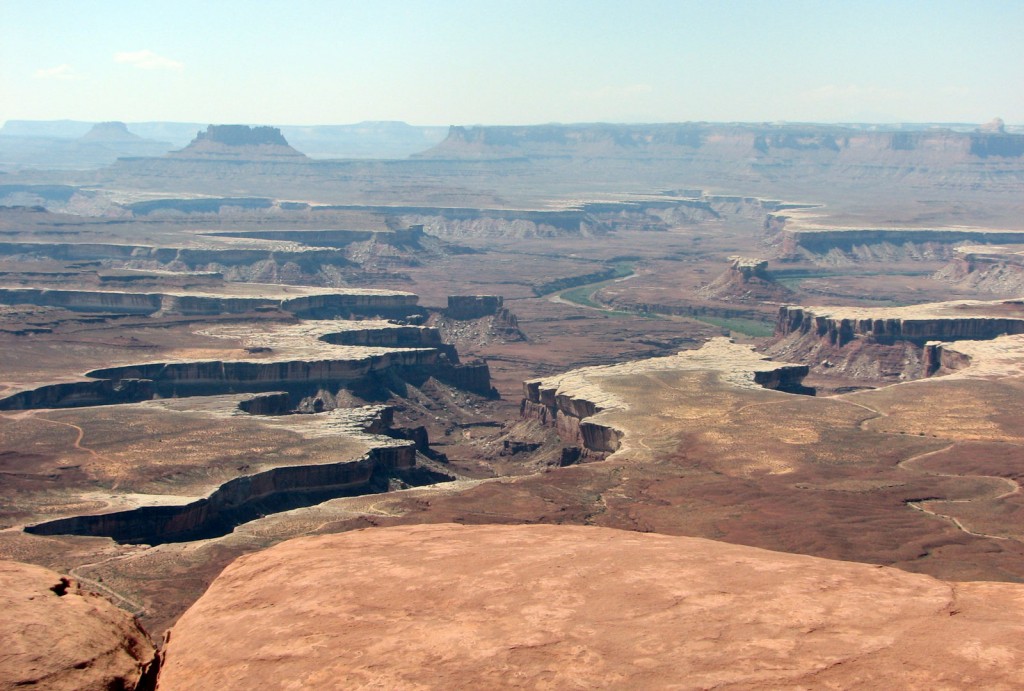
Island in the Sky, a sandstone mesa that rises 1,000 feet above its surroundings. Photo © Bill McRae.
Deep canyons of the Green and Colorado Rivers have sliced through rocks representing 150 million years of deposition. The Paradox Formation, exposed in Cataract Canyon, contains salt and other minerals responsible for some of the folded and faulted rock layers in the region. Under the immense pressure of overlying rocks, the Paradox flows plastically, forming domes where the rock layers are thinnest and causing cracks or faults as pressures rise and fall. Each of the overlying formations has a different color and texture; they’re the products of ancient deserts, rivers, and seas that once covered this land.Views from any of the overlooks reveal that an immense quantity of rock has already been washed downriver toward California. Not so evident, however, is the 10,000 vertical feet of rock that geologists say once lay across the high mesas. The dry climate and sparse vegetation allow clear views of the remaining rock layers and the effects of erosion and deformation. You can read the geologic story at Canyonlands National Park in the 3,500 feet of strata that remain, from the bottom of Cataract Canyon to the upper reaches of Salt Creek in the Needles District.
At Canyonlands it’s easy to be in awe of the deep canyons and big desert rivers. But the little details of Canyonlands geology and ecology are pretty wonderful too. Consider the potholes: shallow depressions dusted with windblown dirt. These holes, which range from less than an inch to several feet deep, fill after rainstorms and bring entire little ecosystems to life.
Pothole dwellers must be able to survive long periods of dryness, then pack as much living as possible into the short wet periods. Some creatures, like the tadpole shrimp, live only for a couple of weeks. Others, like the spadefoot toad, hatch from drought-resistant eggs when water is present, quickly pass through the critical tadpole stage, then move onto dry land, returning to mate and lay eggs in potholes.
Although pothole dwellers are tough enough to survive in a dormant form during the long dry spells, most are very sensitive to sudden water-chemistry changes, temperature changes, sediment input, being stepped on, and being splashed out onto dry land. Humans should never use pothole water for swimming, bathing, or drinking, as this can drastically change the salinity or pH of a pool. Organisms are unable to adapt to these human-generated changes, which occur suddenly, unlike slow, natural changes. While the desert pothole ecosystems may seem unimportant, they act as an indicator of the health of the larger ecosystems in which they occur.
Extremes of flash flood and drought, hot summers, and cold winters discourage all but the most hardy and adaptable life. Desert grasses, small flowering plants, cacti, and shrubs like blackbrush and saltbush survive on the mostly thin soils and meager 8-9 inches of annual precipitation. Trees either grow in cracks that concentrate rainfall and nutrients or rely on springs or canyon streams for moisture. Piñon pine and juniper prefer the higher elevations of the park, while cottonwoods live in the canyon bottoms that have permanent subsurface water. Tamarisk, an exotic and invasive streamside plant, and willows often form dense thickets on sandbars along the Green and Colorado Rivers. The hanging gardens of lush vegetation that surround cliff-side springs or seeps seem oblivious to the surrounding desert.
The fragile desert ecology can easily be upset. Cattle, especially in the Needles District, once overgrazed the grasslands and trampled cryptobiotic crusts and other vegetation.The fragile desert ecology can easily be upset. Cattle, especially in the Needles District, once overgrazed the grasslands and trampled cryptobiotic crusts and other vegetation. Increased erosion and growth of undesirable exotic plants like cheatgrass have been the result. Scars left by roads and mines during the uranium frenzy of the 1950s can still be seen, most commonly in the Island in the Sky District.Fewer than 10 species of fish evolved in the canyons of the Colorado and the Green Rivers. These fish developed streamlined bodies and strange features, such as humped backs, to cope with the muddy and varying river waters. Species include Colorado pikeminnow, humpback chub, bonytail chub, and humpback sucker; most of these live nowhere else. All have suffered greatly reduced populations and restricted ranges as a result of dam building.
Of the approximately 65 mammal species living in the park, about one-third are rodents, and another third are bats. You’re most likely to see chipmunks, antelope ground squirrels, and rock squirrels, which are often active during the day. Most other animals wait until evening to come out and feed; in the morning, look for tracks of mule deer, bighorn sheep, coyotes, gray foxes, badgers, porcupines, spotted skunks, beavers, black-tailed jackrabbits, wood rats, kangaroo rats, and many species of mice.
Excerpted from the First Edition of Moon Arches & Canyonlands National Parks.